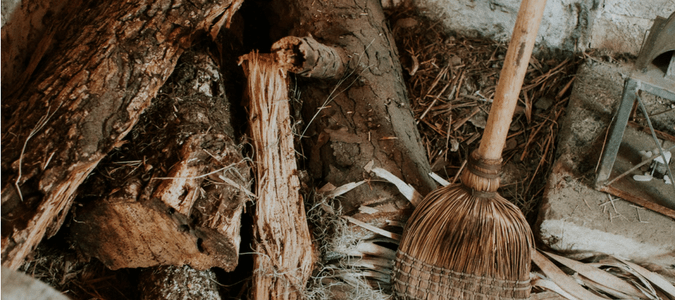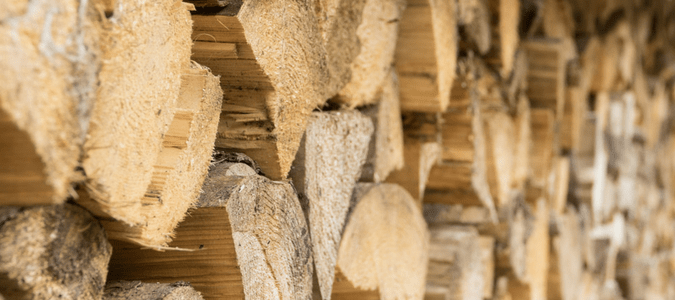
Creosote is a dark, greasy, flammable, and corrosive substance that can build up on the walls of your fireplace and chimney. It forms when unburned wood particles, fly ash and other volatile flue gases combine as they try to escape from your chimney. If there’s a poor draft, these unburned particles and gases often condense and build up on the walls of your chimney.
Cleaning Up Creosote
Without being removed regularly, creosote can cause harm to your home, including adding to your risk of a home fire. If your fireplace is a focal point of your room, the substance also leaves an unsightly residue that takes away from the aesthetic appeal of your room. Let’s talk about why you might find creosote in your chimney or fireplace and how to remove this substance to keep your fireplace looking great and protect your family from a fire in your house.
Causes of Chimney Creosote Problems
There are several reasons that creosote can begin to accumulate in your chimney. A flue too large for a woodburning appliance may increase the likelihood that creosote will build up. Restricted air supply, unseasoned or rain-logged wood, and cool surface flue temperatures encourage creosote residue. Whatever the reason, many homeowners are looking for solutions to remove creosote.
How to Remove Creosote From a Chimney Flue
The solution to getting creosote out of your chimney depends on the severity of the problem. Liquid, powder, or sprays can be applied directly to a fire or to wood in your fireplace to break down creosote into ash, which can then be swept out with the help of a chimney sweep brush. In some cases, the buildup is so severe that flue brushes are ineffective. In those cases, spinning wire whips or other chemical solutions may soften the creosote and enable removal with a flue brush. Proceed with caution, however, as more invasive methods can damage your flue.
How to Remove Creosote From a Wood Furnace
Removing creosote at least once a year is important and can be more challenging if the residue includes a glazed-on coating. It is possible to safely and effectively remove glazed-on build-up in a wood furnace with a creosote remover that contains trisodium phosphate. To do so, you must start a fire, apply the creosote remover and repeat the procedure twice a week for a month. Each month, check and remove debris and use a chimney brush to remove additional residue. You can also add special logs or creosote remover sticks into a well-stoked fire to remove this substance.
Homeowners typically handle Creosote staining on other surfaces. Cleaning creosote from metal, brick, or drywall is not impossible, but depending on how long the stains have been there, it can be pretty challenging.

How to Remove Creosote from Brick
Wear appropriate gear to prevent accidental injury, including non-ventilated goggles, a face mask and rubber gloves when cleaning creosote. To remove creosote from brick, follow these steps:
Prepare the area by placing tarps or plastic sheets or tarps around the fireplace to protect your furniture and window treatments. Open all of the windows and doors to keep the room well-ventilated.
Create a cleaning paste by combining equal amounts of salt and liquid dishwashing detergent in a large mixing bowl. Stir in a half cup of ammonia using a wooden spoon until it turns into a creamy paste.
Apply the paste while wearing rubber gloves by smearing a paste coating over the creosote-saturated bricks. Continue until the entire area is covered. Allow the paste to treat the area for 15 to 30 minutes. Then, you should be ready to scrub away the creosote.
Vigorously scrub the bricks after the paste is mostly dried with a stiff brush or steel wool sponge. Scrub in a circular motion and continue until the paste and creosote are removed.
Clean the bricks by filling a spray bottle with cold water and saturating the bricks. Wipe off any remaining creosote and paste with a clean towel.

How to Remove Creosote from Clothes
You will likely have some creosote on your clothes after cleaning your walls, bricks, and fireplace. Clothes with creosote should be treated first before laundering. Do not try to wash the soiled clothes in the washing machine.
We suggest following these steps to remove creosote from your clothing:
Treat each soiled area like a grease or tar spot using an oil-based substance, and do not let it come in contact with other clothes. Try using lard, WD-40, butter, chicken fat or olive oil on a rag. The oils combine with the creosote, allowing it to lift off the fabric with a clean rag. Wipe the oil in one direction with a lifting motion so as not to smear it into a larger area. Wipe it in the direction of the threads when possible.
Apply a good detergent and some warm water, and work the soap into a lather on the spot(s).
Rinse the rag and repeat until the area looks clean.
Wash the clothing in the washer, as usual, ideally on its own and re-check the stain before drying it. The dryer’s heat will further set stains, so you’ll want to ensure any stains are gone by the time your clothes enter the dryer.
Need Help Removing Creosote from Your Chimney or Fireplace?
Removing creosote is a messy job and a difficult task for the average homeowner to keep up with. For help removing creosote from your chimney or fireplace, look no further than the experts at Capitol Chimney. We recommend regular chimney cleaning at least once a year or more often, depending on how often you use your fireplace.
While the winter season is busy, early spring may be the best time to schedule a cleaning because you beat our fall rush and reduce the likelihood of smoky odors wafting into your home during the summer when your fireplace is not in use. We make it easy to schedule an appointment online, or you can call our offices to reserve a time that works best for your schedule. If you are in Austin, call us at (512) 834-2261. If you live in New Braunfels, contact us at (830) 625-5155.



